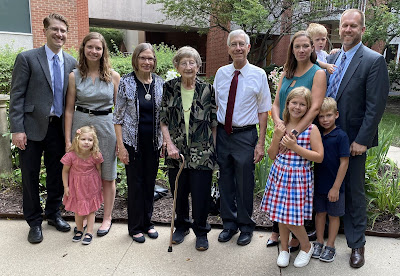It's a three hour trip from Stowe to Bennington across Vermont. We made it last all day. Traveling almost exclusively on roads marked as "scenic byways," we drove mostly below the speed limit and took our time. The autumn colors were spectacular. Though morning fog obscured some, by afternoon we had our sunglasses on, and the mountains were dazzling. We also happened upon several covered bridges, and our route even took us through (over?) one.
Our longest stop was in Woodstock, Vermont. (No, it's not THAT Woodstock. The big rock festival in 1969 was outside of Woodstock, New York, about 150 southwest.) This Woodstock is the quintessential New England town, with beautiful colonial-style homes and a quaint business district with white, wood frame churches sporting tall steeples. Just outside of Woodstock is the Marsh-Billings-Rockefeller National Historic Park. No, we had never heard of it, either.
This 1,000 acres of farms and woodlands was originally platted by in the 1820s by George P. Marsh, who grew up in the area and served several terms in Congress. He was later appointed an ambassador, representing the U.S. in several European countries. While overseas, he studied how European agricultural practices of the day had ruined the land. Upon return home in the mid-1800s, he lamented that the greed for cheap lumber had clear-cut most of Vermont's lush forests. In 1864, he published
Man and Nature, a book that became in that era what
Silent Spring was to the 1960s environmental movement.
In 1869, Marsh sold his huge farm to Frederick Billings, a native of the area who had become wealthy in Western land deals and as a railroad baron. Billings, Montana is named for him. Billings shared Marsh's concern for the land, introducing innovative farming methods and planting thousands of trees. He also built an opulent mansion on the site. (I forgot to get a photo of it, but I stole one from the internet.)
Billings's dream of a model sustainable farm and forest was carried on by his three daughters, and later by a granddaughter. Mary French, the granddaughter, married Lawrence Rockefeller, brother of New York governor and later U.S. Vice President Nelson Rockefeller. Lawrence, and his wife, were active in many environmental causes, and made the Woodstock farm and mansion their home for many decades. After Mary's death in the 1990s, the farm was given as a gift to the National Park Service.
We walked a little over three miles through the woods, had a brief tour of the house, watched an interpretive video, and then walked a bit in the town. We would liked to have eaten lunch in one of the cafes, but the town was packed with tourists. It was difficult to park, and most restaurants had waiting times of an hour or more. We finally went to a supermarket and bought deli sandwiches to eat in the car.
Driving a bit off the beaten track, we visited Quechee Gorge. Referred to by some (at least by some Vermont tourism promoters) as "The Little Grand Canyon of Vermont," the gorge is more than 160 feet deep, and is viewed from a highway bridge in the Quechee State Park. The gorge gets its name from the Ottaquechee River, which flows through it.
More driving along "scenic byways" took us through many more miles of beautiful fall colors, but we made few stops. One was at the Robert Frost farm, where the poet lived and worked through much of the 1920s.
Once in Bennington, we visited the monument to the Battle of Bennington. This Revolutionary War victory was actually fought across the state line in New York (not far -- from a high point you can see New York from here). But the battle saved the town of Bennington from being sacked by the British, and also kept the British from seizing vital supplies that were being stored here at that time.
We also paid a visit to "First Church," or First Congregational Church of Bennington. The cemetery next to the church is the oldest burial ground in Vermont. Robert Frost and most of his family members are buried here, as are a number of Revolutionary War heroes, five former U.S. Senators from Vermont, and a variety of other notables from the colonial and revolutionary eras.
Mary had identified a couple of fine places to eat in Bennington, but oddly, we found that the entire downtown area pretty much rolled up their sidewalks on Sunday evenings. All we could find was a rather unusual pizza place. It was not unusual for its pizza, which was average, but for the layout and the way business was done. We ordered our pizza from a high school girl at one counter, but had to step over to the bar -- which was crowded with raucous local football fans who had been drinking all afternoon -- to order our drinks. Then we had to go back to the pizza girl to pay the bill for everything. It was odd, and not what we were looking forward to. But we did not go to bed hungry.




















































